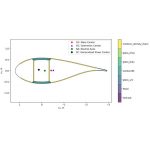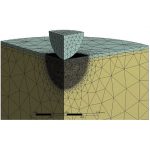Air Force to help fund AnalySwift, Weber State Project Aimed to Improve Advanced Air Mobility
Contract funds effort to extend cutting-edge helicopter blade simulation software to the composite blades used in the rapidly expanding Advanced Air Mobility, ORB market
West Lafayette, Indiana (USA) – If you mentioned “flying cars” a few years ago in conversation, you’d likely conjure farfetched images from science fiction. Today, this concept is closer than further from becoming a reality thanks, in part, to the US Air Force’s recently launched Agility Prime, a non-traditional program seeking to accelerate the commercial market for advanced air mobility vehicles (i.e., “flying cars”).
These vehicles, often referred to as ORBs by the Air Force, include Advanced Air Mobility (AAM), Urban Air Mobility (UAM), Electric Vertical Takeoff and Landing (eVTOL), and more. With varied applications, including urban transportation, cargo transportation and product delivery, medical evacuation, firefighting, disaster relief, security, and search and rescue, these vehicles have uses far beyond defense.
AAM vehicles have several defining features, one of which is they all hover on rotor blades. However, despite great strides in understanding and modeling rotor blades for larger vehicles, such as helicopters, blades for these smaller vehicles are part of an emerging market with unique features and characteristics of their own.
Helping address this challenge, AnalySwift, LLC, is partnering with Weber State University (Weber State), Brigham Young University (BYU), Utah Advanced Materials and Manufacturing Initiative (UAMMI), and Hexcel. The contract is funded through the Air Force’s Small Business Technology Transfer (STTR) program, which funds small businesses partnered with research institutions to conduct cutting-edge research and development relevant to the agency.
Specifically, the contract with US Air Force’s AFWERX program is to develop a framework for the design of composite rotor blades used in Advanced Air Mobility vehicles. While blades made from composite materials offer many advantages to traditional materials in terms of weight and performance, they are complex and difficult to model. Such blades can be made of dozens of separate layers of advanced composite materials, creating challenges when conducting design and analysis. For instance, representing these blades in a computer model could require billions of degrees of freedom to accurately capture all the engineering properties, overwhelming even high-end computing resources.
Realizing these challenges for helicopter rotor blades over 30 years ago, the US Army began funding development of an engineering software technology called VABS. Through cutting research at Georgia Tech, Utah State University, and Purdue University, the software matured over time to be able to compute all the properties of composite rotor blades efficiently and accurately by modeling the very complex blades using simple engineering beam theories. Using VABS, engineers gained the ability to confidently evaluate the performance of existing composite blades, convert legacy blades made from traditional materials to composites, as well as design blades for desired behavior, naturally setting the stage to move beyond aerospace to tackle problems in other industries, including wind turbine rotor blades in renewable energy.
To accomplish this, several key research tasks are being carried out, including development of the framework at AnalySwift to extend VABS’ capabilities to AAM blades, materials research and qualification at Weber State, manufacturing simulation at BYU, and industry collaboration with UAMMI, a Utah-based organization integral to both the composites industry and AAM. Corporate partner, Hexcel, is providing innovative composite materials, that may one day be the standard for AAM rotor blades.
The overarching goal of this project is to enable rapid development and certification of AAM vehicles through a digital engineering framework for this critical component, namely the rotor blade. It will not only extend the capabilities of VABS from helicopter rotor blades to AAM blades, but it also links several other programs and capabilities with VABS as well in a user-friendly framework.
Weber State is becoming an epicenter for the applied study of composites. The university’s new post-graduate Systems Engineering and Sustainable Engineering Certificate as well as two new state-of-the-art engineering buildings support their advanced teaching and research. Weber State professor of mechanical engineering Daniel Magda will lead technical efforts to qualify materials provided by Hexcel for properties important in the performance of composite blades, such as stiffness and strength. This testing according to ASTM standards is important for qualifying the materials as inputs for the blade modeling framework.
BYU is a private research institution with a newly created department of Manufacturing Engineering focusing on both theory and hands-on learning of common manufacturing processes. BYU has expertise in modeling and simulation of resin infusion composites processing. Under the direction of associate professor Andy George, BYU will perform flow simulation and infusion process optimization for low void content for blade and manufacturing constraints to AnalySwift to incorporate into the design.
Some of the key benefits of the envisioned final product include improved vehicle competitiveness with extremely rigorous simulation of composite rotor blades, reduced time to market with orders of magnitude reduction in analysis time, less reliance on costly and time-consuming experiments, and a convenient engineering platform for wide usage that doesn’t require FEA (finite element analysis) expertise to operate. These benefits potentially add up to significant time and cost savings for those developing AAM vehicles.
More specifically, the VABS-enabled framework can help deliver AAM blade engineers the best complete set of beam properties, which are needed for static/dynamic design and analysis of rotor blades as well as the complete set of accurate stresses/strains/strength ratios for assessing the structural safety of the blades. The VABS program is extensively validated in helicopter and wind industry for accuracy. VABS is highly optimized for ply-level details modeled in seconds and the resulting framework from this project will be versatile, with no requirement for user to be FEA expert. The full press release is also available here.
About AnalySwift
AnalySwift, LLC is a provider of composite simulation software, which enables an unprecedented combination of efficiency and accuracy, including multiphysics structural analysis and micromechanics modeling. Drawing on cutting edge university technology, AnalySwift’s powerful solutions provide customers a competitive advantage through drastic reductions in engineering time, virtual testing earlier in the design process, and handling of more complex composite structures. The company’s technologies deliver the accuracy of detailed 3D FEA at the efficiency of simple engineering models, cutting analysis time by orders of magnitude. SwiftComp is licensed from Purdue Research Foundation. VABS is licensed from Utah State University, Georgia Institute of Technology, and Purdue University. Find out more at analyswift.com.
Media Contact:
Allan Wood
(801)-599-5879
info@analyswift.com
www.analyswift.com











